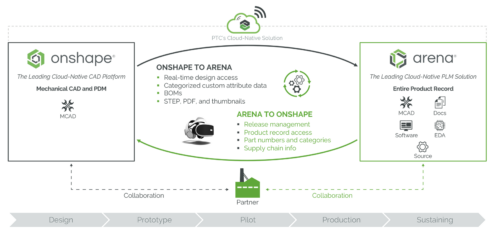How Cloud-Connected CAD and PLM Drive Collaborative and Streamlined Product Development
 Why do many products fail?
Why do many products fail?
There are several factors that contribute to companies not reaching their commercialization targets. Some include:
- Lack of understanding of the end-user goals and challenges
- Inability to mitigate risks or unforeseen disruptions
- Poor product quality or design
- Lack of product differentiation
To illustrate, the Segway Electric Scooter’s introduction was met with a fast demise in 2001 due to its inability to solve consumers’ real-world problems1. Although the technology was considered cutting-edge, it was too slow, difficult to maneuver, and did not adequately address market needs. In the case of Google Glass wearable technology, it was pulled from the market in 2015 due to a bulky design, lack of practical features, and privacy concerns2.
CHALLENGES OF REMOTE COLLABORATION AND OUTSOURCING IN PRODUCT DEVELOPMENT
Product failures like that of the Segway Electric Scooter and Google Glass are hitting closer to home for today’s innovators with the shift to remote work practices as well as the outsourcing of more design and production work to contract manufacturers (CMs). Because product teams are distributed and collaborating in virtual environments, there’s a greater opportunity for missteps to occur throughout the product development process. It’s difficult for everyone to address design changes, part shortages, quality issues, and other bottlenecks that impact a product launch—especially when they rely on disconnected systems. Additionally, it is harder to get all the key stakeholders, including customers, on board and solicit their input.
In a recent webinar, Mike Halladay, Principal Solution Consultant at Arena, a PTC Business discussed how a connection between cloud-native CAD, PDM, and PLM systems enhances collaboration across global product teams and partners to help them overcome these obstacles and reach their new product development and introduction (NPDI) goals. Here are key takeaways from Mike’s presentation.
NPDI REQUIRES CROSS-FUNCTIONAL TEAM COLLABORATION EARLY AND OFTEN
Despite the changing work environment, companies still need to innovate fast so that they can gain first-mover advantage and reap the profits from new technology. By collaborating early and often, dispersed product teams and supply chain partners can streamline processes and accelerate time to market.
Best practices for virtual team collaboration and product development include:
Provide visibility across the entire enterprise.
Involve downstream product team members (e.g., operations, quality, procurement), contract manufacturers, and suppliers in design reviews and gather their input early on. This ensures that everyone stays aligned on features and the product’s intended use. Additionally, teams can quickly address any issues that may impact production.
Consult with customers throughout the product development process.
Use prototypes to gain insights from customers on product functionality and physical attributes. This will ensure that the final product fulfills their requirements and that there are no surprises after launch.
Maintain a steady pace.
Work in parallel to avoid bottlenecks and drive faster product releases.
Focus on maximizing value.
Ensure that the NPDI process enables your business to reap the most value by meeting customer expectations, reducing costs, and driving profitability.
CLOUD-NATIVE TECHNOLOGY SUPPORTS PRODUCT COLLABORATION AND OPERATIONAL EFFICIENCY
Cloud-native solutions are business-ready and fundamentally designed to support collaboration across distributed teams. The systems are much faster and less expensive to implement, eliminating the need for additional hardware or extensive coding. Regular software enhancements are delivered to customers without any downtime, and customers can easily connect different cloud-native systems using flexible integration tools like event engines and REST APIs. Because collaboration best practices and security controls are inherent with cloud-native technology, organizations don’t have to reinvent processes. Ultimately, businesses can get up and running quickly and focus on getting their products to market.
THE POWER OF A CLOUD-NATIVE CAD, PDM, AND PLM CONNECTION
Connecting your computer-aided design (CAD) or product data management (PDM) system to a product lifecycle management (PLM) solution in the Cloud provides greater visibility not just for the engineering team but also for extended product teams and external partners. Everyone can easily access designs and contribute their feedback early in the development cycle to ensure design for manufacturability (DFM), reduce costs, and avoid product delays. A connection between systems also allows for process automation and the reduction of errors stemming from manual data imports and exports.

Onshape-Arena Connection Drives Agile and Fast Product Development Processes
Dynisma, a pioneer in automotive and motorsport simulation, has joined a growing number of innovators that now leverage the cloud-native connection between Onshape CAD and Arena PLM to enhance collaboration across their cross-functional teams and streamline product development processes even further.
Collaboration is vital in what we do. Our designers and engineers need to be able to run through different ideas and tweaks in real time. Being in the Cloud means we can access our product information anywhere in the world with an extremely efficient way of logging any changes. Everyone is always working on the right design at the right time.
Matt Bell, Head of Mechanical Engineering, Dynisma
The ability of extended product teams and partners to access designs via PDFs and 3D neutral CAD files using the Onshape-Arena Connection facilitates earlier and more frequent input across the entire enterprise. With one click, the product bill of materials (BOM) as well as the release, revision, and change management process are synchronized across both CAD and PLM systems. This allows teams to continually fine-tune and optimize designs within faster iteration cycles and meet ever-changing customer requirements.
Companies also benefit from less administration and easier system configuration. Due to the systems’ cloud-native infrastructure, no complex integrations or middleware are needed to set up or maintain the Connection. “It has been a real game changer adopting a solution that can be executed so efficiently in the Cloud,” stated Matt Bell, Head of Mechanical Engineering at Dynisma.
NPDI SUCCESS IS WITHIN REACH
In this time of constant change and increasing product complexity, manufacturers need turnkey and robust digital solutions to drive seamless collaboration and keep their distributed teams in sync. Innovators like Dynisma are a testament to how embracing cloud-native technologies like Arena and Onshape can eliminate the typical product development hurdles and keep commercialization success within reach.
To hear Mike Halladay talk more about connected CAD and PLM and see a demo of the Onshape-Arena Connection, watch our on-demand webinar.
References


